At the beginning of the 20th century, a team of international paleontologists prepared to excavate a cave located in a limestone formation known as Dragon-Bone Hill, a few hours outside of Beijing. The Cave of Zhoukoudian had traditionally been the haunt of dragon bone collectors, eager to find remnants of a legendary creature that had been celebrated in Chinese mythology for centuries. As the band of scholars approached the cave, no one could predict the significance of the ancient cache that lay within, and the modern-day nationalistic mythology that it would later spawn and that can still be felt in China today. That find became known as Peking man.
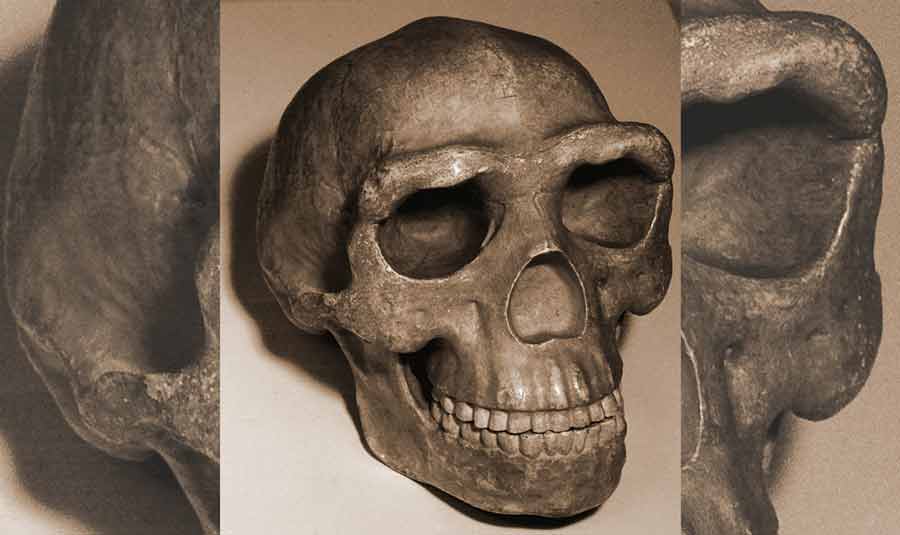
Uncovering Fossils of Peking Man
Of course, there were no dragon bones in the cave, only the fossils of long-dead mammals, which was one of the first features that J. G. Anderson, a Swedish geologist, W. W. Granger, an American paleontologist, and O. Zdansky, an Austrian archaeologist working as Anderson’s assistant, noticed about the site. The first excavations started in 1921, unearthing a series of quartz fragments, suggesting that at one time in the distant past man had called the cave home.
Next, in 1923, Zdansky discovered a set of two human-like teeth, which was further complemented in 1927 by the uncovering of a well-preserved lower molar by Swedish paleontologist Birger Bøhler. Davidson Black, a professor of the Peking Union Medical College, recognized its significance, assigning it as a new type of hominin group called Sinanthropus pekinensis (Peking man).
- Tooth from Prehistoric Woman Reveals Life and Times of Peking Man
- 10 Spectacular Treasures That Have Never Been Found
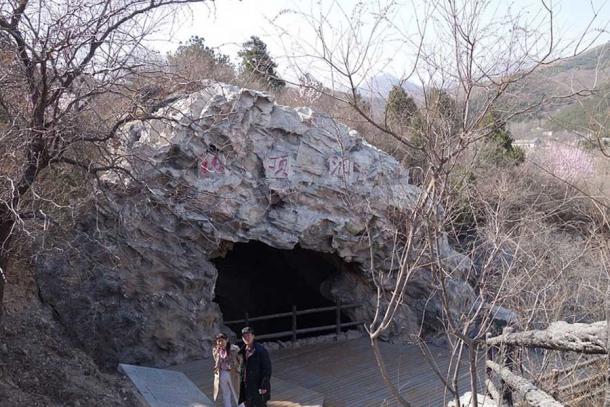
The upper cave at Zhoukoudian in China, where evidence of Peking man was unearthed. (Siyuwj / CC BY-SA 3.0)
Under the stewardship of Pei Wenzhong, who ran the dig site between 1928 to 1935, several more major surprises would crop up as work continued, despite the Japanese invasion of northern China from 1931. The most exciting artifact was the first complete cranium dug up in 1929, allowing scientists to study in greater detail the inhabitants, who were christened with the name Peking man.
Although excavations stopped from 1935, they were once again resumed in 1949 with the establishment of the People’s Republic of China (PRC), which sparked a renewed interest in the evidence for early man contained within its borders. Over 1950 fossils of more than 40 men and women have been found at the cave, thousands of stone tools and artifacts, the fossilized remains of plants, and the bones of 96 unique varieties of mammal.
The wealth of the archaeological trove proved the continuous occupation of the cave during a staggering 200,000 years, making it the place with the longest history of human habitation ever found. It has enabled archaeologists to reconstruct a detailed picture of the life of Peking man, which has subsequently been integrated into a dangerous and erroneous Chinese archaeological narrative.
Delving into the Hundreds of Peking Man Fossils
The hundreds of fossils catalogued during excavations of the Cave of Zhoukoudian were broad in variety and scope. The finds included six complete and partially complete skulls, 12 skull fragments, 15 pieces of mandibles, 157 teeth, three humerus fragments, one clavicle bone, seven femur fragments, a piece of tibia, and one wrist bone remnant called a lunate bone.
In comparison to modern man, Peking man had a few notable differences. Although the bones of its body resembled modern man, it was the strangeness of the skull that excited scholars, who may have thought they were close to identifying the ultimate prize in archaeology, that of the missing link.
The skull of the Peking man was thicker and flatter and had jutting brows, and the brain case, which had an average of 1,054 cubic centimeters (64.3 cu in), was much larger than other forms of early man such as the Java Man, a type of Homo erectus that entered the evolutionary stage 1 million years ago and whose cranial capacity was only 900 cubic centimeters.
Because cranial size usually increases the further up the evolutionary ladder, with modern humans having an average size of 1450 cubic centimeters, it was suggested that Peking man represented a later stage of development after Homo erectus and before modern Homo sapiens. Other noticeable features were the size of the Peking man’s teeth, which were larger and sturdier than the teeth of Homo sapiens and had traces of an ancient substance called cingulum, an enamel collar traditionally associated with prehistoric man.
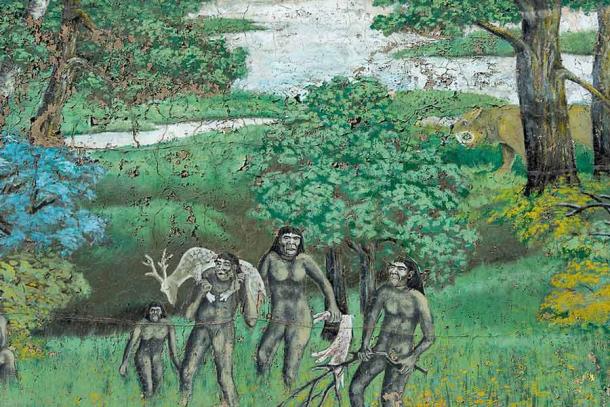
Mural depicting a Peking man hunting party at the Zhoukoudian Museum. (xiquinhosilva / CC BY 2.0)
Evidence of Tool-Making Spanned 200,000 Years
Another stunning characteristic of the excavations were the numerous examples of primitive tools, whose development could be traced within the 200,000-year time frame available to researchers. Evidence suggested an advanced level of knowledge of tool-making techniques, as the Peking man was not exclusively dependent on the customary water-rounded pebbles found in other ancient groups, instead using other material such as vein quartz and rock crystals from nearby geodes.
The tools could be categorized into three different production methods: anvil percussion, direct percussion, and bipolar percussion. The earliest practice was anvil percussion, which involved a large flat stone being forcefully hit with a sandstone piece. The flakes gathered from the sandstone were then employed as bladed tools. Stone tools found in the 8th to 10th layers made with this technique, from 460,000 to 420,000 years ago, are the earliest examples of Peking man’s stone implements, which had an average weight of 50 grams (1.76 oz) and a length of 60 millimeters (2.36 in).
In the middle period, the indiscriminateness of anvil percussion was ditched in favor of bi-polar percussion, a process that used a flat stone as a platform to hold vein quartz which was then bashed with the vertical blows of a hammer-stone. Tools from this epoch, produced 370,000 to 350,000 years ago, were twice as small, with an average weight of less than 20 grams and a length of less than 40 millimeters (1.57 in), owing to more intentional and finely-tuned procedures.
During the final stage between 300,000 to 230,000 years ago, represented in the tools uncovered in layers 1 to 5, smaller tools increased by 78% and more advanced materials were increasingly favored by prehistoric craftsman who used more flint and less coarse stone. A further technique accompanying all periods was direct percussion, where the flint was held in one hand and flakes were smashed off it by a hammer-stone tool in the other hand.
One of the most striking indicators of the Peking man’s advanced technological know-how was their mastery of fire. From the very beginning of their time in the Cave of Zhoukoudian it was evident that these early humanoids knew how to handle fire, with four big layers of ash being identified by researchers ranging from 460,000 to 290,000 years old.
Scattered ash piles implied the Peking man knew how to kindle a fire for a long period of time, as there is no evidence they knew how to start a fire. Peking man likely used the fire produced by the natural world in the form of thunderstorms and transported it back to their cave for maintenance. Fire was a response to the coldness of their environment, which resembled an inter-glacial climate similar to the conditions of present-day northern China.
Hunting and Primitive Communism
The cornucopia of bones recovered at the Cave of Zhoukoudian illustrated that Peking man were skilled hunters able to compete successfully with other carnivores. The largest quantity of bones in the entire excavation came from 3,000 individual deer split into two types called the thick-jawed deer and the sika deer, suggesting that they could efficiently kill larger mammals which were their main source of meat and protein.
Elsewhere, the fossilized seeds of the Chinese hackberry have been retrieved, which were roasted by Peking man as a supplementary addition to their diet alongside walnuts, hazelnuts, pine, elm, and rambler rose.
Hunting detritus constitutes the main evidence for social cooperation and primitive communism. Firstly, it shows that Peking man preferred to live together in groups rather than as individuals, as hunting was an extremely difficult task more likely to succeed with teamwork. The sheer volume of mammal bones found in the cave further implied communal coaction, as hunting kills were probably taken back to the cave to be shared by the other habitants rather than eaten on the spot.
Furthermore, it’s very possible that the society of the Peking man was based on the division of gender labor, as hunting, which required strength and endurance, was usually practiced by the man. Following the patterns of many other hunter-gatherer tribes, the woman would be the gatherer of the Peking man, foraging for berries and fruits.
Another major point that supported the cooperation of Peking man was their tool-making culture, which spanned an incredible 200,000 years, and has been interpreted as the earliest example of education in human society, as tool-making secrets were passed down orally from generation to generation and continuously developed to produce more advanced equipment.
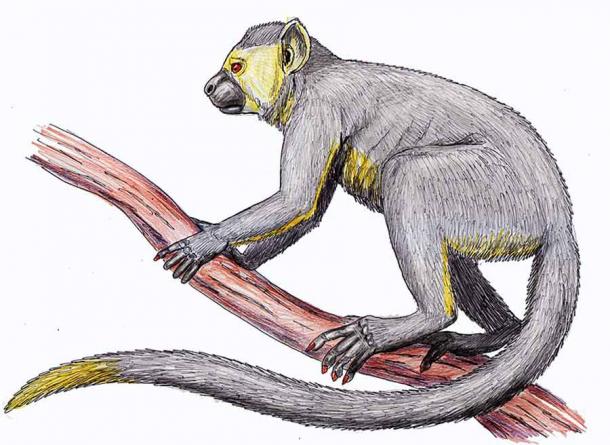
The discovery of Eosimias sinesi, seen in the illustration, in China was seen as evidence by the Chinese of an ape which spawned modern Homo sapiens. (DiBgd / CC BY-SA 4.0)
Peking Man and the Chinese Theory of Evolution
The People’s Republic of China have employed the Peking man as the star of their national evolutionary theory, arguing that the first human originated in China rather than Africa. This was a bid to convince the world that the Chinese were the Earth’s most original modern human habitants. This line of enquiry is in stark contrast to the Out of Africa theory favored by most scholars, which posits that humans emerged from East Africa 200,000 years ago and that Homo sapiens replaced, rather than were the product of, Homo erectus.
The paleontological nationalism of the Chinese originally developed from a discredited theory posited in the 1930s by archaeologist Franz Weidenreich, who advanced the notion that there were several different processes of evolution for different human races. To him, the Peking man was the forbearer to the Chinese race, an argument that delighted government ideologues keen to prove the uniqueness of China in the development of mankind.
The earliest humans came from the Qinghai-Tibet Plateau, according to government-sponsored researchers who have used other finds alongside the Peking man to prove that a separate Chinese race evolved. The 1986 Wushan Man, for example, is lauded as the earliest human ancestor of the Chinese to walk upright, and the 1995 discovery of Eosimias sinesi was enthusiastically attributed as the most ancient type of anthropoid ape to exist which spawned modern Homo sapiens.
The Peking man is heralded as the developmental stage before the emergence of the modern Chinese, with Skull 101 remaining the key evidence for PRC claims. They believe that the skull has “mongoloid” or Chinese features, a claim they have also echoed in earlier Homo erectus discoveries in China. Wu Xinzhi, a Chinese anthropologist, exemplified this when he described Skull 101, as having a “flat front face but projecting cheekbones, shovel-shaped incisors, a low nasal bone, and rectangular-shaped eye sockets.”
Throughout the 20th and 21st centuries, China has encouraged its academics to support a nationalistic paleontological slant. The Peking man, however, was not initially catapulted to national myth, as between 1927 to 1949 it was only mentioned twice in Chinese history textbooks. With the establishment of the People’s Republic of China in 1949 however, interest in the Peking man was resurrected and its story was implemented into nationalistic symbolism.
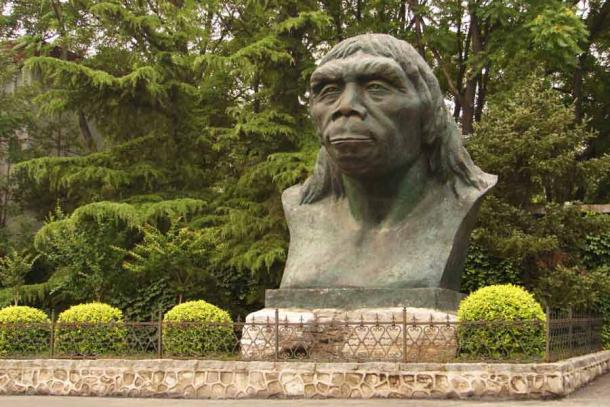
Statue of the Peking man from the entrance of the Zhoukoudian site. (Diego Tirira / CC BY-SA 2.0)
In 1963, Chinese premier Zhou Enlai encouraged Chinese academics to “reassess the things unearthed, many ancient relics and documents from the Marxist-Leninist viewpoint and clarify history.” The objective was that “in this way, it will be possible to break down many fetishes and superstitions [and) strengthen national dignity and patriotism.”
An explosion in patriotism in the 1990s further propelled Peking man and other archaeological discoveries into the national spotlight, and from the middle of the decade the Peking man was reserved as a major topic in Chinese textbooks. In 1998 the Chinese government went further and launched a sweeping archaeological survey called the Study of Evolution of Early Hominid and the Related Environmental Background, in an attempt to create a complete fossil series that would rival proponents of the Out of Africa theory.
In popular culture, the Peking man has been used as a unifying tool. His use of fire, which Chinese scholars argue was the first in human history, has been celebrated in major televised events such as the inauguration of the Chinese Centennial Monument in 2000. Its famous fire, entitled the Altar of the Sacred Flame, was obtained from wood-drilling in the cave of Zhoukoudian by actors pretending to be cavemen on the last day of the millennium, and transferred to the monument by 50-kilometer (31 mi) relays to signify the so-called China century.
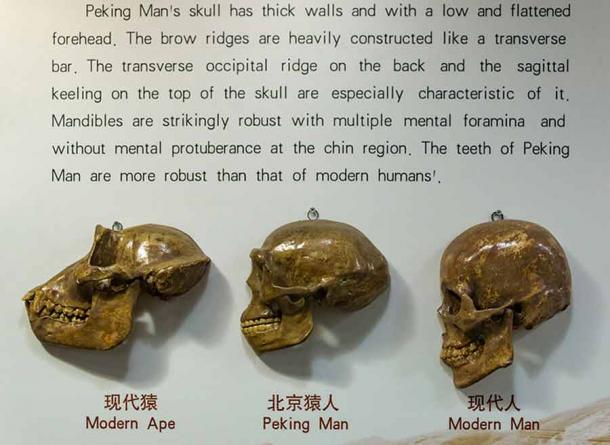
Information panel from the Peking Man Museum which depicts the Chinese archaeological and nationalistic narrative. (xiquinhosilva / CC BY 2.0)
The Danger of Paleontological Narratives
The Chinese narrative, which stretches the evidence by leaps and bounds in the interests of nationalism rather than well-balanced academic enquiry, has been heavily discredited and criticized. The lack of hominin discoveries in China in comparison to Africa, which continues to regularly produce fossils, illustrates that Africa was a much more genetically diverse region of the world in the distant past, which is an indicator of its greater age.
When something is discovered in China, PCR officials are quick to exaggerate the importance. Rampithecus, for example, was heralded as the earliest ape ancestor of the Chinese, even though examples of it are more commonly found outside of China in southeast Asia, and it was likely the predecessor of an ancient line of apes rather than humans. The Peking man was no different, being that it was seemingly a failed offshoot of Homo erectus that died out in the icy climates of northern China.
Perhaps the strongest riposte to China’s claims are the MtDNA studies of the 1980s, which investigated the DNA sequences of humans from Africa, Europe, and Japan, showing that all humans had a common African ancestor. It proved that the Chinese were not evolutionarily different or special in any sense, arriving as Homo sapiens into China around 60,000 years ago.
- Use of Fire by Peking Man Goes Back 600,000 Years, Chinese Scientists Say
- Ancient Human Fossils found in China Challenge Out-of-Africa Theory
Yet, the Chinese are not unique in their nationalistic emphasis on archaeology, which has been employed by other nations in history such as Japan, Israel, and England. In England, the Piltdown man found in 1912, which had a human skull and an ape’s jaw, was revered as the missing link and the “earliest Englishman” by patriotic English paleontologists before it was revealed to be a patched-together hoax in 1953.

The practice of using paleontology and archaeology for the construction of a nationalistic narrative is nothing new. The Piltdown man was an elaborate hoax back in 1953. (Public domain)
In China, however, the consequences of jingoistic paleontology have taken a darker turn. PCR academics who have bravely defied the PCR-sanctioned version of ancient history in favor of the Out of Africa hypothesis continue to suffer intense online abuse for their opinions and are often societally shunned. Even more worrying is the emergence of assertions of racial superiority over Africans from Chinese who refuse to believe they are the descendants of prehistoric Africans.
In 2018, the Chinese Communist Party’s Spring Festival derogatorily featured a black actor in a monkey suit and other actors in blackface, and in 2020, in response to the coronavirus pandemic, the African population of Guangzhou were evicted from their homes and forced to live on the streets despite having valid visa paperwork and proof they didn’t have the virus. The Peking man and its associated nationalistic theory thus remains a stark reminder of the power and danger of xenophobic narratives of archaeology in the present-day and the inappropriate use of the ancient world for a racist agenda.
Top image: Reconstruction of the Peking man skull. Source: kevinzim / CC BY 2.0
By Jake Leigh-Howarth
References
Bae, C. 2009. “The People’s Peking Man (review)” in China Review International, 16:2.
Cheng, Y. 2017. ““Is Peking Man Still Our Ancestor?” – Genetics, Anthropology, and the Politics of Racial Nationalism in China” in The Journal of Asian Studies, 76:3.
Lambert, T. 2020. “Peking Man and Chinese Superiority” in The Rabbit Hole. Available at: https://rabbitholemag.com/peking-man-and-chinese-superiority/
Rukang, W. And Shenglong, L. 1983. “Peking Man” in Scientific American, 248:6.
Sautman, B. 2001. “Peking Man and the Politics of Paleoanthropological Nationalism in China” in The Journal of Asian Studies, 60:1.
Sui, C. 2020. “China’s Racism is Wrecking Its Success in Africa” in Foreign Policy. Available at: https://foreignpolicy.com/2020/04/15/chinas-racism-is-wrecking-its-success-in-africa/